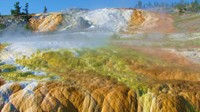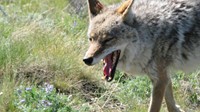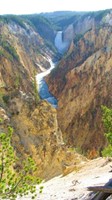I’ll recount the closest I’ve gotten to death on the CDT. And no, it didn’t involve a grizzly bear.
As I left the Grand Teton National Park, I walked into another National Park: Yellowstone. By cutting through the southwest corner of Yellowstone, the CDT misses out on the majority of the park, which is a crime.
Therefore, I used my dad’s map from the 1950s to plan a route through the park that would take me counterclockwise around Yellowstone Lake, thereby seeing most of the park (and hiking many extra miles). I plan to see the CDT portion on the way back. My dad’s 50-year-old map had no topography, but I figured I could deal with the mountains by now. Little did I know that the real challenge wouldn’t be the mountains, but the rivers.
As I approached Heart Lake I saw a creek that looked like it had cool tasty water. Before scooping up some, I dipped my finger in the flowing stream. The water was as hot as a Jacuzzi. Higher up, there was a thermal vent releasing boiling hot water and steam that could burn the flesh off your skin in seconds. Lower down, I dipped my hands in the warm stream. Little did I know that soon I would be dipping my entire body in a very cold stream.
My dad’s map showed that the trail crosses the Yellowstone River. I realized this would be a formidable river, but I wasn’t worried at all. Yellowstone is a National Park and gets far more funding than other parks. National Parks are so loaded that their trails often have nice cut steps, clear signs, and bridges over even the most pathetic streams. Therefore, I had no doubt that Yellowstone would have a spectacular bridge hanging over the mighty Yellowstone River.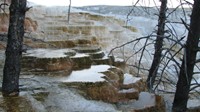
When I finally arrived at the Yellowstone River, my jaw slowly dropped. No bridge.
I looked upstream. Nothing. Downstream. Nada.
Meanwhile, the massive volume of water swept by emotionless. This river is the main inlet to Yellowstone Lake, the second largest high altitude lake in the world. To fill up such a large lake, you need a lot of water flow. I tried to come up with reasons I had made a mistake. I couldn’t accept that I had to cross it.
At first I thought I had gotten off the trail. However, there was big, bright trail marker on the tree behind me, confirming that I was precisely on the trail.
“Then I must walk along the river to find the bridge,” I said to myself.
Before marching along the river, I scanned across it. I couldn’t believe my eyes: I saw a trail a pair of huge, bright trail markers on the other side, daring me to cross the river.
I fell to my knees and moaned, “No, no, no…. this just can’t be…”
The river was about 50 meters across (half a football field) and three meters deep.
I was positively, absolutely, and completely dumbfounded. No matter how much I stared at the river, a bridge refused to materialize.
After shaking my head for 15 long minutes, I resolved to cross the swift, deep river. I stuffed my most valuable possessions in a stow sack, and then put that in a large Ziplock bag. I wrapped everything I around my ground sheet and wrapped all that around my tarp. I emptied my 3-liter Platypus water bladder and filled it up with air to add buoyancy to my backpack. I shoved all that into my backpack, which is water resistant since it is made of Silnylon. Finally, I tied my umbrella to my backpack to make sure it wouldn't flow away once I started swimming. In short, since I knew I'd be in the water for a while, I had multiple layers to keep my most valuable gear dry.
Before jumping in, I remembered that I was in the most remote part of the 48 contiguous states. The southeast corner of the park is ironically called the Thorofare area, even though nobody goes there.
Therefore, if I got into trouble, who knows when someone would find me. I hadn't seen anyone since I left the Tetons.
Although it was 10 a.m. and the temperatures were starting to warm up, the river, which is fed by the melting snow in the mountains, was cold. Therefore, I planned to plunge into the river with my wind pants and wind jacket on, hoping it would create a minor layer of warmth. I knew they would dry within 10 minutes and my base layers were stowed away deep in my pack.
The longer I waited, the swifter the river would get and the more the volume would increase as the sun melted more snow on the mountaintops. I couldn’t wait any longer.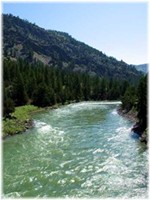
I jumped into a shallow portion of the river, where the current was relatively slow compared to the middle section that was moving swiftly. Even though the water just came to my knees, I found it hard to stand. The current was nearly knocking me off my feet. Cold water enveloped my legs as I struggled to walk forward a couple of meters.
“This is insane,” I thought. “If it’s this hard to stand in this river, imagine how far it’s going to carry me downstream when I get into the middle of the river where it's really moving....”
The more I debated, the colder my feet would get. I started to cross. Just a couple of meters from the river's edge, I was already up to my chest in water. I couldn't walk any longer. With my backpack slung over just one shoulder, I jumped forward and started swimming.
The unsympathetic river immediately flung me downstream. With every stroke I made to go across the river, the current swiftly pushed me downstream.
In Colorado, I would get frustrated with the snow. However, at least when I wanted to move forward, I would go forward, albeit slowly and with much effort. On the Yellowstone River I wanted to go forward, but instead I was going sideways. I saw the trail sign across the river pass me by as if I was on a bus driving by it. It was nuts. It was the first time on the trail I felt out of control.
My wet shoes felt like bricks on my feet, making it hard to kick through the water. The cold water made me numb and started to slow me down. I was hyperventilating.
As I struggled to make forward progress, a wave of water hit my face and water entered into my mouth. I choked a bit and then coughed it up.
"That sucked," I thought, "But I gotta admit it tasted pretty good..."
As the river mercilessly and methodically moved me downstream, I realized I was halfway across. It was the point of no return. I couldn't turn back and I had to swim for my life. I had to sprint to the other side or become a Yellowstone statistic. For the first time on the trail, I was worried about my safety.
It was awkward swimming with a backpack strapped over one shoulder. I could feel my heart racing and my lungs gasping for air. Despite all my conditioning, I was quickly running out of steam.
Just as I was feeling fatigued, the current relented slightly. Still, I struggled to stay afloat. In desperation I hoped that I was close enough that I could stand up.
As the river pushed me along I lowered my leg to see if I could touch the bottom. My toe hit the bottom. I thrust myself forward with a couple more stokes and got a solid footing. I stood up as the water kept slamming me at my waist. I sloshed forward and gasped a sigh of relief.
Although it only took about 60 seconds to cross those 50 meters, I was completely spent. For the next 10 minutes I continued breathing hard as water dripped down my clothes.
"And I thought I was in good shape," I gasped.
I opened up my backpack to assess the water damage. I was astounded that the backpack and the tarp were enough to keep everything dry. Everything inside the tarp was completely dry. All those extra layers of protection weren't necessary. I have no clue what my backpack was doing while I was crossing, since I was too busy just trying to swim. However, I suspect the air-filled Platypus helped keep the backpack riding on the water instead of sinking.
Here's a nice, romantic picture of how the river looks a few miles downstream.
Seems so easy and tranquil, no?
Eventually I would have to ford the Beaverton River. It was only half as wide and half as deep as the Yellowstone River. Luckily, it also didn't have any alligators.
I couldn’t believe that Yellowstone National Park didn’t have a bridge over these rivers. It didn’t make any sense. By the way, the latest Yellowstone topo maps don't indicate that you need to ford the Yellowstone River. To learn more about the Yellowstone River and see more pictures, visit Wikipedia.
The rest of park
Fortunately, the rest of the park was easy. About half the trails I was on were officially closed due to "bear activity," but I went through anyway. After fording the Yellowstone River, I wasn't worried about some silly bears who are capable of ripping me to shreds.
Along the Lake, I met some Christians who were working at the park for the summer. Meghan was warm and welcoming even though I missed their religious service. She brought me sandwich and drove me to a ranger station so I could get a permit. She impressed me with her selflessness and gen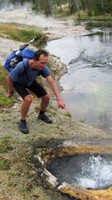
Armed with a new camera I walked along the Yellowstone's Grand Canyon, which isn't nearly as cool as the real Grand Canyon, but it's still spectacular. I reached the top of Mt. Washburn (10,300 feet) and was overwhelmed by all the day hikers who were there. It was the first (and only) time that I saw anyone on a trail in Yellowstone.
I spent my last evening in Yellowstone at Mammoth Springs. While admiring the magical formations a budding professional photographer struck up a conversation with me. His name was Matt and he was working for the Park Service. He toured me around the various terraces and eventually invited me to crash in his guest room. He was living in the 2nd oldest building in the park and its historical ambiance took me back over 100 years. Once again I was blessed with trail magic in Yellowstone!
I've left Wyoming behind and now I'm going to hug the Idaho/Montana border for the next few hundred miles. I'm about 40% done.
The Fourth of July is almost here, so you might enjoy this hilarious 60-second spot.
Sponsor spotlight: Pristine
Pristine makes purifying safe, light, and easy. What more does a backpacker need? Chlorine Dioxide is safe and easy to use. I've been using it on all my backpacking trips over the last 5 years. At 2.8 ounces, it's far lighter than a pump!
Please visit: www.Pristine.ca
